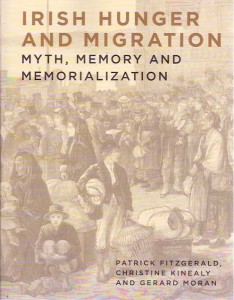IRISH HUNGER AND MIGRATION: MYTH, MEMORY AND MEMORIALIZATION
Published in Book Reviews, Issue 1 (January/February 2016), Reviews, Volume 24PATRICK FITZGERALD, CHRISTINE KINEALY &
GERARD MORAN (EDS)
Quinnipiac University Press
$35/€30/£25
ISBN 9780990945406
Reviewed by Liam Kennedy

Ten million people emigrated from the small island of Ireland to other parts of the world between 1700 and the present. Some were adventurers, some were social outcasts, some were missionaries and some were fleeing war and famine. Most were economic migrants, seeking a better life elsewhere. These are Irish stories but also stories of the human family, as we see most nights on our television screens.
We tend to think of the Great Famine as dominating the story of Irish emigration. This is not so, as this thematically rich study of hunger and migration makes clear. Nonetheless, the Famine migrations constituted the great peak in Irish outward migration. During those terrible years, 1845–51, well over a million people—sometimes on their own, sometimes in family groups—took part in a massive exodus to Britain and North America. Smaller numbers found niches in other parts of the world.
Irish hunger and migration is a multi-faceted set of studies that takes in Irish migration to the Caribbean in the mid-seventeenth century (I hadn’t appreciated the importance of small Munster ports in the transatlantic trade in indentured servants), the changing regional, religious and ethnic colouration of migrants through time, the relatively forgotten famine of 1879–81 (was this more subsistence crisis than famine?), famine memory in the Old and New Worlds (sometimes inscribed in the landscape in the form of place-names and monuments), and, particularly welcome, reflections by Brian Lambkin on how the Famine still haunts the present in the north of Ireland.
There are, in addition, explorations of Quaker-inspired famine relief in Ireland and Finland and snatches of memories of the Irish Famine in North American fiction, not to forget the role of the Grey Nuns of Montreal in the care of refugees streaming into that city. The Irish Famine has gone global and the disciplinary boundaries have been stretched in so many directions that our understanding of the catastrophe literally knows no bounds. Patrick Fitzgerald, Christine Kinealy and Gerard Moran have done a fine job in shaping these new understandings.
Whether the island of Ireland has two separate diasporas or just one is a meta-theme that courses through the volume. Sometimes it is subterranean. At other times it breaks the surface, as in Lambkin’s concluding chapter. The historian A.T.Q. Stewart is usually credited with the notion that there was (is?) a Protestant diaspora that was especially visible at the time of the third Home Rule crisis of 1912. It was unionist in political sympathies, with supporters stretching from Chicago and New York to Sydney and Cape Town. It was largely Ulster-centred. In more recent decades, following Partition, the home place (or, for some, the homeland) tended to be Northern Ireland rather than Ulster.
Then there is the much more visible Irish Catholic diaspora, nationalist in political orientation and frequently, if erroneously, held to constitute the ‘Irish diaspora’. Its more extreme fringes tended to be consumed with Anglophobia, be it the dynamiters of the 1880s or the Noraid supporters of a century later. But if we can have two diasporas, with all the cross-currents within each (many eighteenth-century Ulster Presbyterians were republican and many 21st-century northern Catholics are quietly and implicitly unionist), what of the adherents of the Church of Ireland in southern Ireland? These are surely not members of the Scotch-Irish, Ulster Scots, Irish Presbyterian diaspora, then or now. Do we need a trinity of diasporas, then, to encompass the complexity of the Irish diasporic identities? Might one speak of an Irish Anglican diaspora? Or should the view be widened still further to locate Irish population movements within the larger frame of the Irish and British islands?
One of the strengths of the volume is its visitation of famines or near-famines other than the Great Irish Famine itself, thereby casting oblique but illuminating light on the greatest tragedy in modern Irish history. A case in point is the little-known famine in Nova Scotia in the mid-1840s, the culprit, as in Ireland, being Phytophthora infestans. The difference was that the administration in Nova Scotia moved quickly and decisively to aid the stricken areas. And, unlike the case of the United Kingdom, the ideology of laissez-faire and fears of disrupting food markets did not prevent food and other supplies being made available to those at risk of starvation. Even within the Empire there wasn’t a uniform response to local food crises.
The Finnish subsistence crisis of 1857 is traced in detail by Andrew Newby. Though overshadowed in the literature and in historical memory by the Great Finnish Famine of 1867, crop failure was severe and hunger widespread. As in Ireland, the Quakers were to the fore in offering aid and mobilising a wider aid effort. Lessons from the Ireland of the 1840s were transferred to Finland. The outcome was incomparably better, though it is only fair to acknowledge that the challenge was of much shorter duration. There were 33 deaths per thousand of the population in 1856–7, which presumably refers to total deaths rather than excess deaths caused by famine and famine-related diseases.
Hunger and forced migration still challenge the global community. Not only is the past still with us but also it is at least clear from the history of the famines touched on in this volume that migration can be an effective form of famine relief. And as the evolving Quaker relief programmes demonstrated, it proved possible to draw lessons on famine relief from the Great Hunger in Ireland. Small silver linings in the midst of vast tragedy, one might say. This is a nuanced study of hunger and migration produced by an outstanding group of historians and related specialists.
Liam Kennedy is Professor Emeritus of Economic and Social History at Queen’s University, Belfast.
















